Tai chi for seniors with visual impairments offers a gentle, accessible path to improved balance, reduced fall risk, and enhanced well-being. This ancient practice, renowned for its slow, flowing movements and meditative qualities, can be tailored to meet the unique needs of individuals with limited sight.
Tai Chi for Seniors with Visual Impairments: Gentle Movements for Better Balance
Tai Chi offers a gentle way for seniors to stay active and healthy. For those with visual impairments, it can be especially helpful.
Tai Chi can improve balance, reduce falls, and boost confidence in seniors with limited sight.
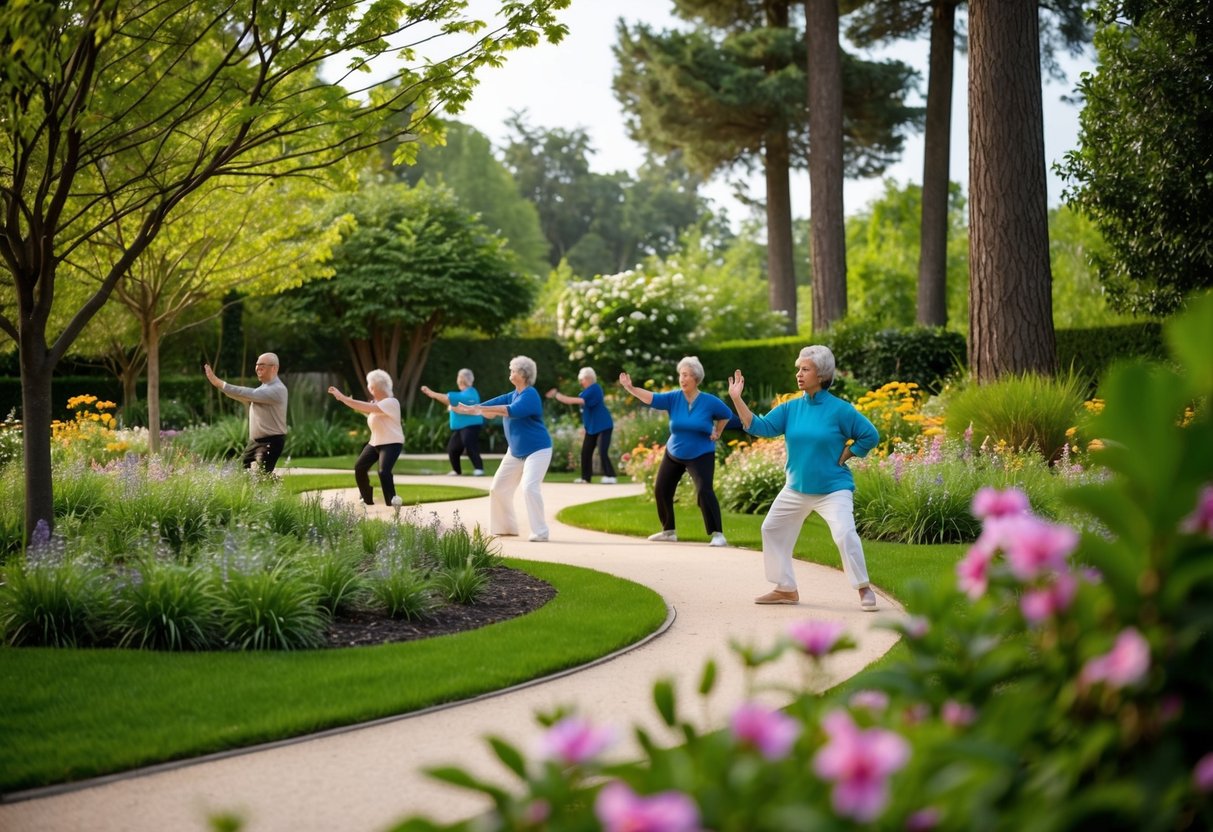
You might think Tai Chi requires perfect vision, but that’s not true. With some small changes, seniors who can’t see well can still enjoy and benefit from this ancient practice.
Tai Chi uses slow, flowing movements that are easy to learn and adapt.
Many seniors with visual impairments find Tai Chi calming and fun. It’s a chance to move your body, clear your mind, and connect with others.
You don’t need special equipment or a lot of space. Just a willingness to try something new and take it slow.
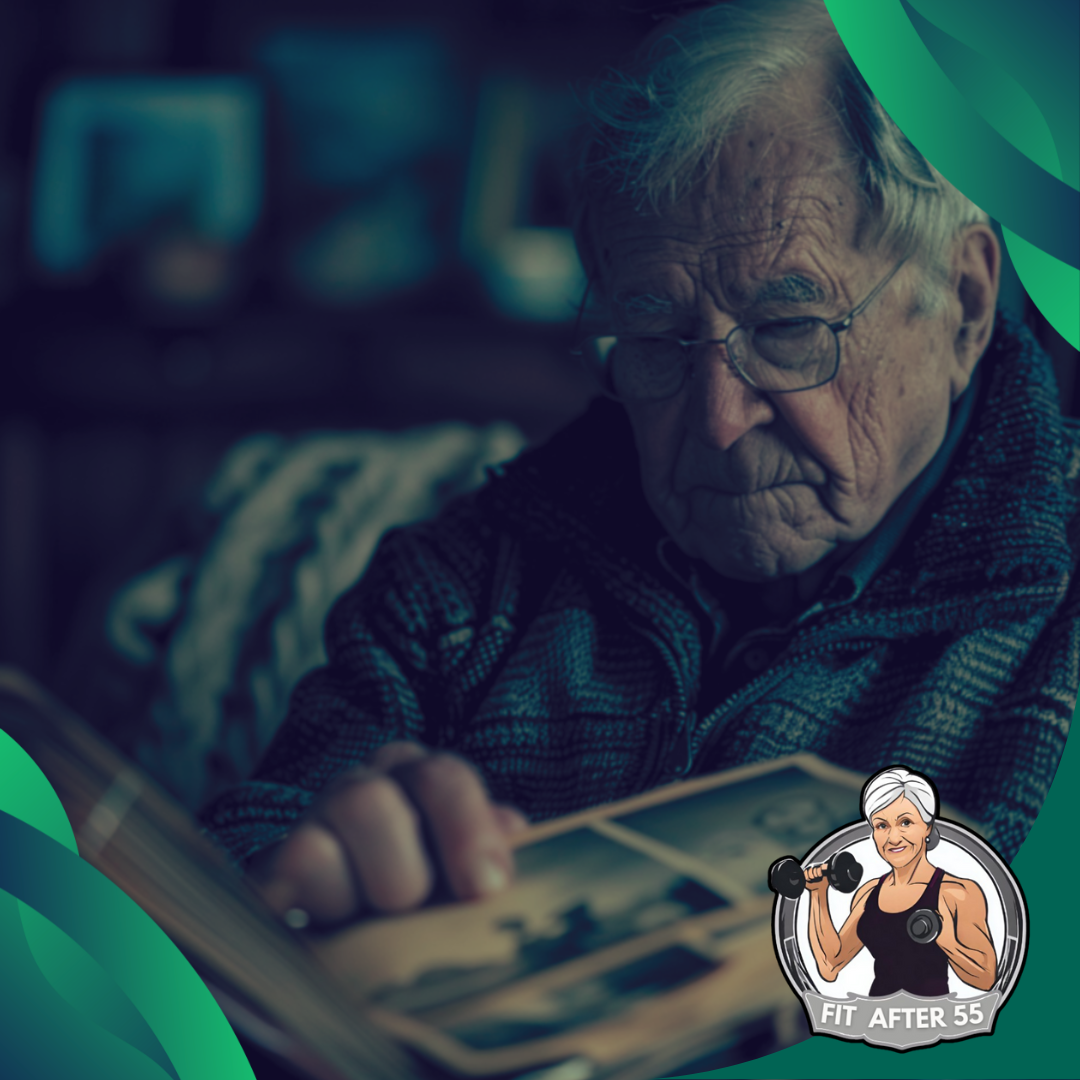
Key Takeaways
- Tai Chi can help seniors with visual impairments improve balance and prevent falls
- The practice can be easily adapted for those with limited sight
- Regular Tai Chi can boost confidence and overall well-being in visually impaired seniors
Understanding Tai Chi
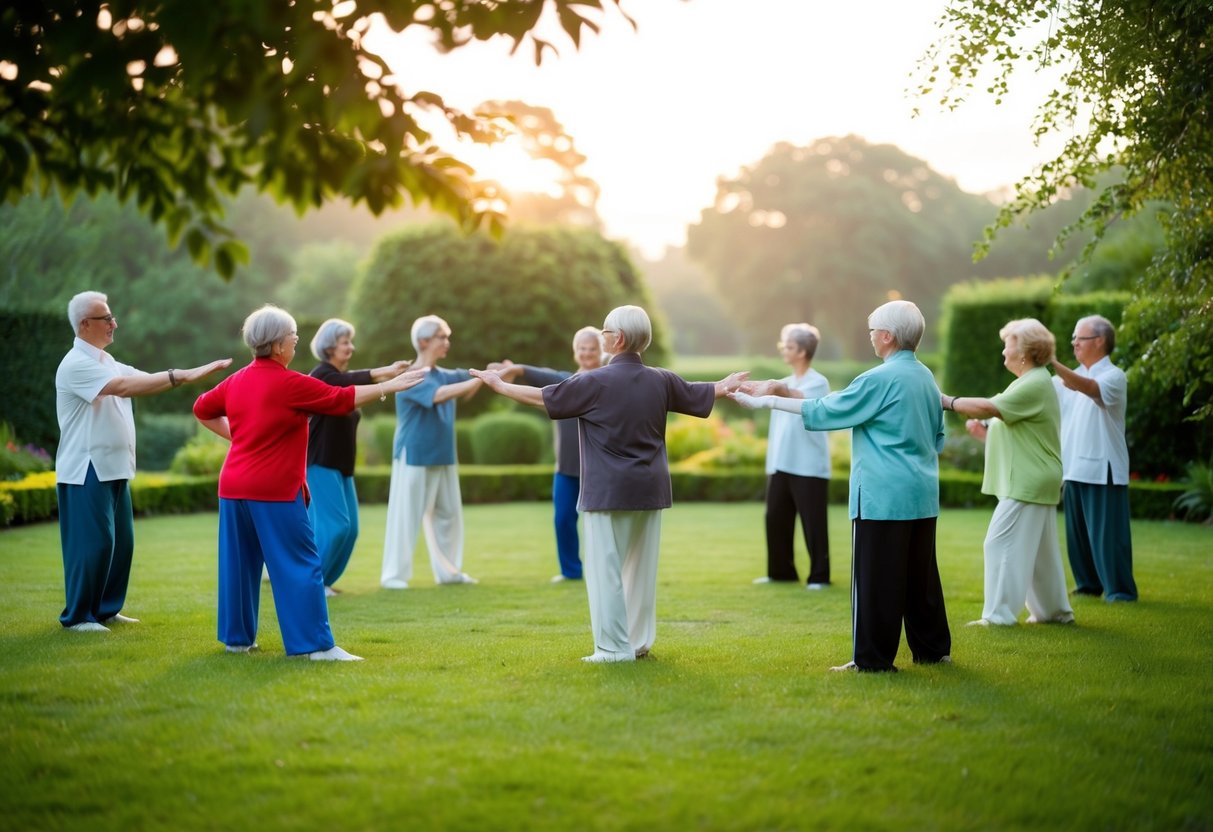
Tai Chi is a gentle exercise that can help you feel better in your body and mind. It uses slow, flowing movements and deep breathing to improve your health.
You’ll learn about where Tai Chi came from, its different styles, and how it can benefit you.
Origins and Philosophy
Tai Chi began in China hundreds of years ago. It started as a martial art but became a way to stay healthy too. The ideas behind Tai Chi come from old Chinese beliefs about energy called “Chi” flowing through your body.
When you do Tai Chi, you try to move this energy smoothly. It’s like a moving meditation. You focus on your breath and how your body feels. This helps you become more aware of yourself and the world around you.
Tai Chi teaches you to be calm and balanced. It can help you feel more peaceful in your daily life.
Tai Chi Styles and Forms
There are different types of Tai Chi. The most common ones are:
- Yang style
- Chen style
- Wu style
- Sun style
Yang style is the most popular. It has slow, gentle movements that are good for beginners.
Each style has “forms.” These are sets of moves you learn. Some forms are short with just a few moves. Others are long with over 100 moves. You can start with easy forms and work up to harder ones.
Qigong is like Tai Chi. It focuses more on breathing and energy. Many people do both Tai Chi and Qigong.
Benefits of Tai Chi
Tai Chi can help you in many ways:
- Better balance
- More flexibility
- Stronger muscles
- Less stress
- Sharper mind
It’s good for your heart health. Tai Chi may lower your blood pressure and improve your quality of life.
Your bones can get stronger too. This helps prevent falls and fight osteoporosis.
Tai Chi can boost your mood and help you sleep better. It may even improve your memory and thinking skills.
You can do Tai Chi almost anywhere. It’s safe for most people, even if you have health problems.
Tailoring Tai Chi for Seniors
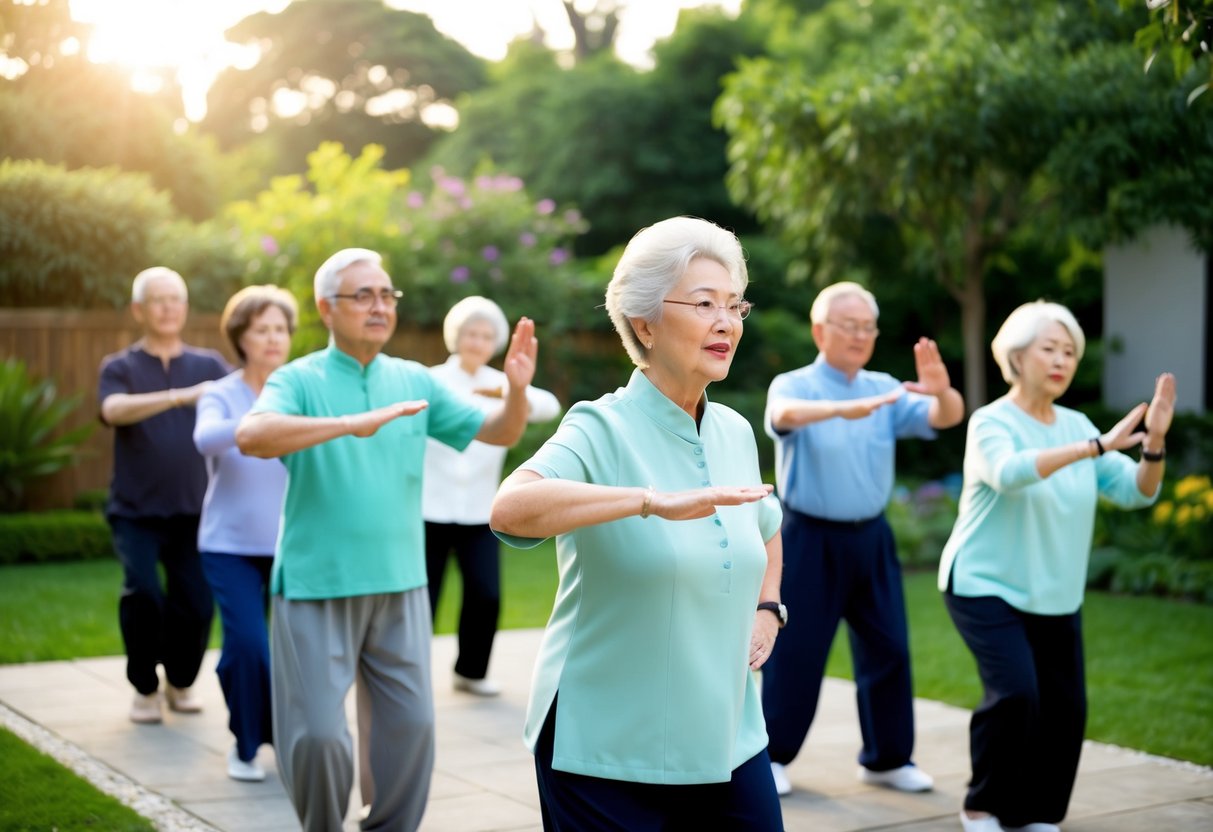
Tai Chi can be adapted to meet the unique needs of older adults. It offers many health benefits while being gentle on the body.
Adapting Tai Chi Exercises
You can modify Tai Chi to fit your abilities. Chair exercises and seated Tai Chi are great options if standing is difficult. These versions help improve your flexibility and strength while being easier on your joints.
For those who can stand, focus on slow, controlled movements. This helps build core stability and balance. Start with basic poses and gradually add more complex ones as you get stronger.
Stretching is a key part of Tai Chi. Take extra time to warm up your muscles and joints before starting. This can help prevent injury and increase your range of motion.
Addressing Common Senior Health Concerns
Tai Chi can help with many health issues common in older adults.
If you have knee osteoarthritis, gentle Tai Chi movements can ease pain and improve mobility. The slow, flowing motions are easy on your joints.
For those with COPD or breathing issues, Tai Chi’s focus on deep breathing can help. It may improve your lung function and boost your energy levels.
Tai Chi is also great for reducing your risk of falls. The Moving for Better Balance program is designed to improve balance in older adults. Regular practice can help you feel more stable on your feet.
If you have fibromyalgia, the gentle movements of Tai Chi may help manage pain and improve your quality of life. Always check with your doctor before starting any new exercise program.
Conducting Tai Chi with Visual Impairments
Tai Chi can be a great exercise for seniors with visual impairments. With some adaptations, you can enjoy the benefits of this ancient practice safely and effectively.
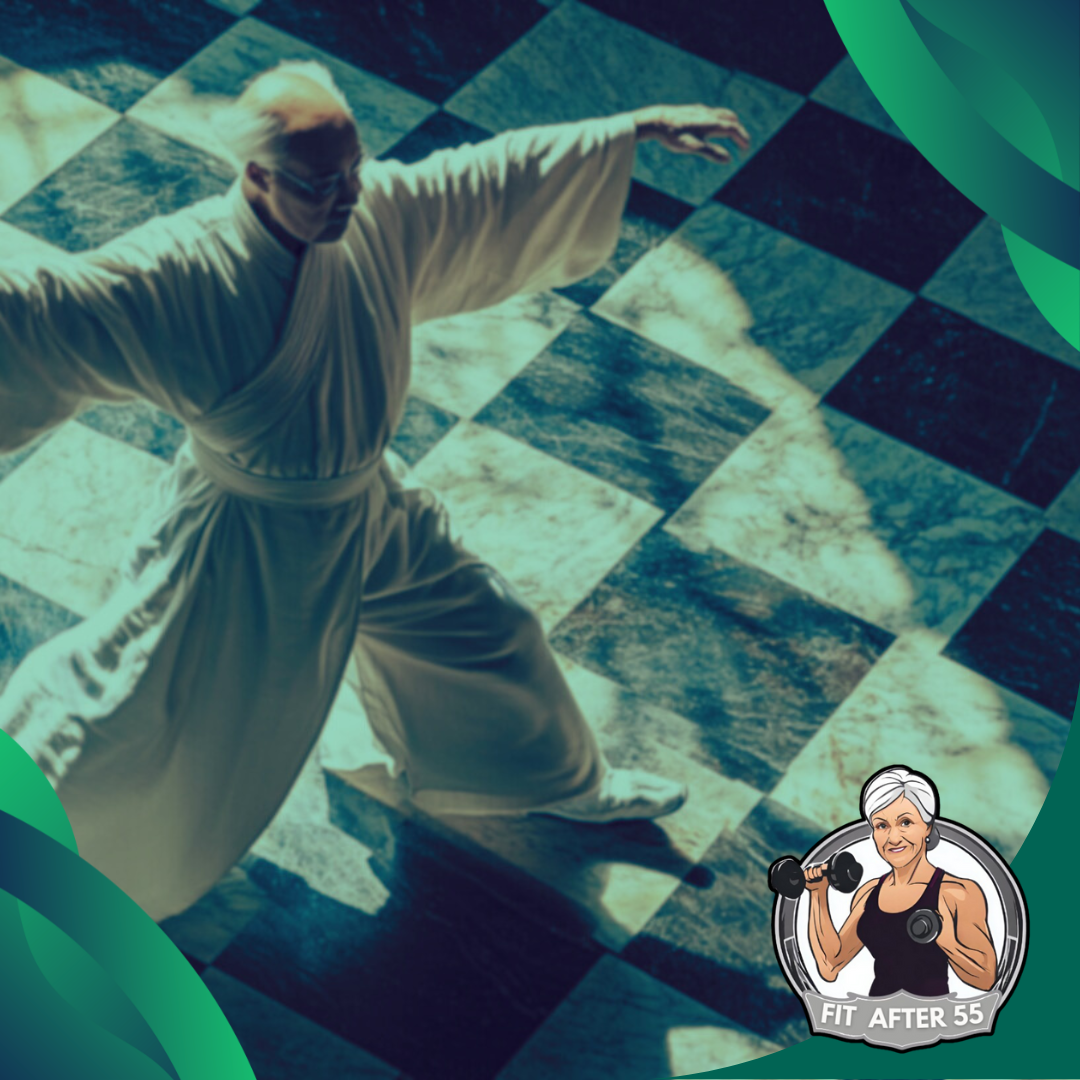
Creating a Safe Environment
To practice Tai Chi with visual impairments, you need a safe space. Clear the area of any obstacles or tripping hazards. Use non-slip mats for better grip. Make sure the room has good lighting if you have some vision.
Tai Chi classes for visually impaired seniors should have plenty of space between participants. This helps prevent accidental bumping into others during movements.
Consider using tactile markers on the floor. These can help you stay oriented in the space. You might use tape or textured mats to create boundaries.
Utilizing Assistive Techniques
There are many ways to adapt Tai Chi for visual impairments. Your instructor can use verbal cues to guide you through movements. They might also use touch to help you understand the correct postures.
Modified movements can make Tai Chi more accessible. For example, you might start with seated Tai Chi to build confidence. As you progress, you can try standing exercises with support if needed.
Focus on developing your body awareness and proprioception. This can help improve your balance and reduce fear of falling. Tai Chi can enhance your stability and knee proprioception, even with visual impairments.
Practice with a partner or use a wall for support when learning new moves. This can help you feel more secure as you build strength and balance.
Practical Application of Tai Chi
Tai Chi offers many benefits for seniors with visual impairments. You can easily add it to your daily routine and improve your balance and strength. Let’s explore some practical ways to use Tai Chi in your life.

Incorporating Daily Tai Chi Routines
Start your day with a 10-minute Tai Chi session. Focus on gentle movements like “White Crane Spreads its Wings”. This move helps improve your arm strength and balance.
Try these simple steps:
- Stand with feet shoulder-width apart
- Raise your arms slowly to shoulder height
- Lower them gently back down
Repeat this 5-10 times. As you get better, add a slight bend in your knees.
You can do Tai Chi while seated too. This is great for everyday activities like watching TV or waiting for appointments. Try slow arm circles or gentle torso twists.
Remember to breathe deeply during your practice. This helps reduce stress and improve mental focus.
Exercises for Core Stability and Mobility
Tai Chi can boost your core stability, which is key for fall prevention. Here are some exercises to try:
Standing Knee Lifts:
- Stand behind a chair for support
- Slowly lift one knee, hold for 3 seconds
- Lower and repeat with the other leg
- Do 5-10 lifts per leg
This exercise strengthens your core and improves balance.
Seated Spine Twist:
- Sit up straight in a chair
- Place your right hand on your left knee
- Gently twist to the left
- Hold for 5 seconds, then switch sides
This move increases spine mobility and works your core muscles.
Always listen to your body and move at your own pace. With regular practice, you’ll notice improved balance and core strength.
Maximizing Health Outcomes
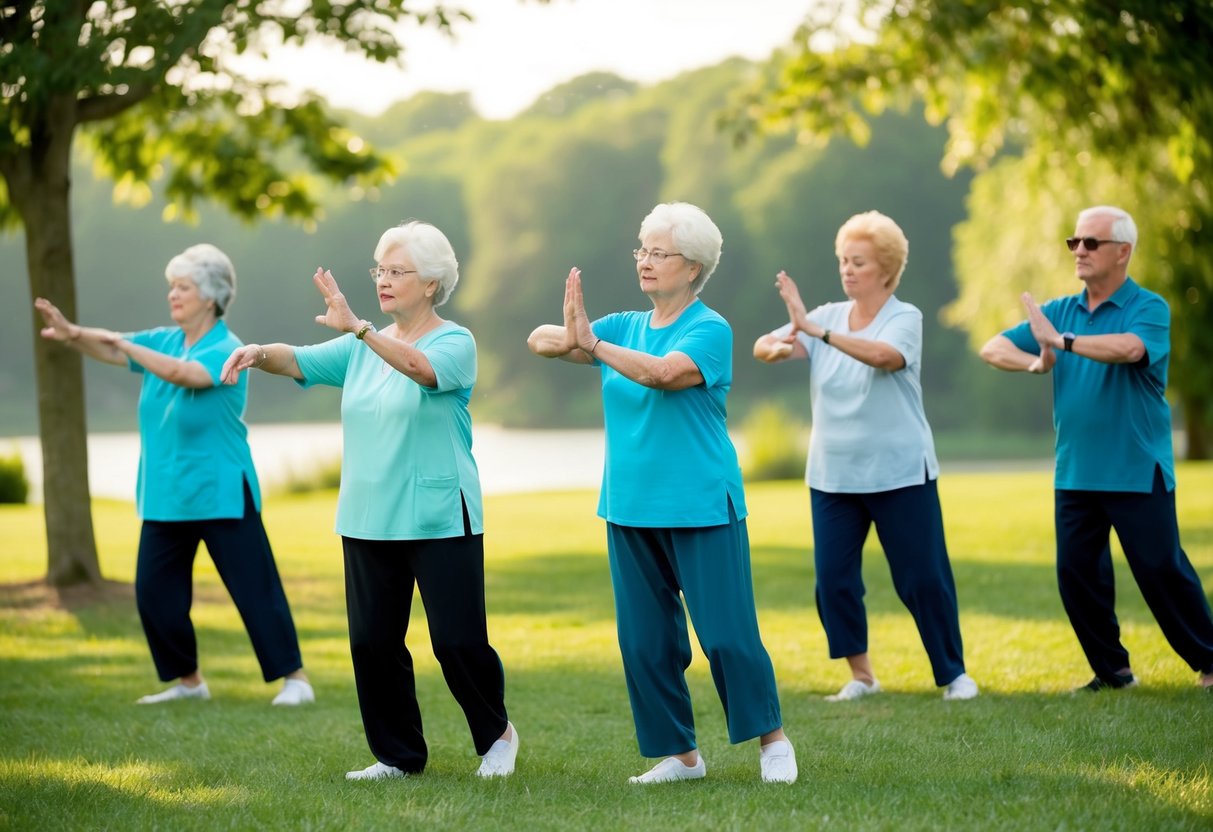
Tai Chi offers many benefits for seniors with visual impairments. It can boost your physical and mental health while also improving your social connections.
Physical and Mental Benefits
Tai Chi is a low-impact exercise that’s great for your body and mind. It can help improve your balance and mobility, which is especially important if you have vision problems.
Regular practice may boost your cardiovascular health and increase your energy levels. You might even see improvements in your sleep quality.
Tai Chi can also help with weight management and building muscle strength. These benefits are crucial for maintaining your independence as you age.
For your mental health, Tai Chi may help slow cognitive decline and reduce stress. The mindful movements can calm your mind and improve your focus.
Enhancing Social Well-Being
Joining a Tai Chi class can expand your social circle. You’ll meet new people who share your interest in staying active and healthy.
Group classes provide a supportive environment where you can make friends and feel part of a community. This social aspect is vital for your overall well-being.
Practicing with others can boost your confidence and self-esteem. You’ll learn new skills and achieve goals together, creating a sense of accomplishment.
Tai Chi can also improve your quality of life by reducing feelings of isolation. Regular social interaction can lift your mood and give you something to look forward to each week.
Adjustments for Different Skill Levels
Tai Chi can be adapted for seniors with visual impairments at various skill levels. You can start with simple moves and work your way up to more complex forms as you gain confidence.
Beginner Techniques for Seniors
Start with sitting Tai Chi to build a strong foundation. This helps you focus on proper breathing and gentle movements without worrying about balance. Try basic arm circles and leg stretches while seated.
As you get comfortable, stand up and practice the “Wave Hands Like Clouds” move. This simple side-to-side motion helps improve your coordination. Remember to take breaks when needed and use a chair for support.
Work on your balance by doing the “Golden Rooster Stands on One Leg” pose. Start by holding onto a sturdy chair, then gradually reduce your support as you gain strength.
Progressing to Advanced Practices
Once you’ve mastered the basics, you can move on to more challenging forms. Try the “Parting the Wild Horse’s Mane” sequence to build strength and flexibility in your arms and torso.
Practice the “Grasp the Sparrow’s Tail” move to improve your coordination and memory. This sequence combines several movements and helps boost your energy levels.
As your endurance grows, work on longer forms like the “24-Form Yang Style.” Take your time learning each part, focusing on smooth transitions between moves.
Join Tai Chi classes designed for visually impaired seniors to get personalized guidance. Your instructor can help you refine your technique and suggest adaptations for more complex moves.
Overcoming Challenges and Common Misconceptions
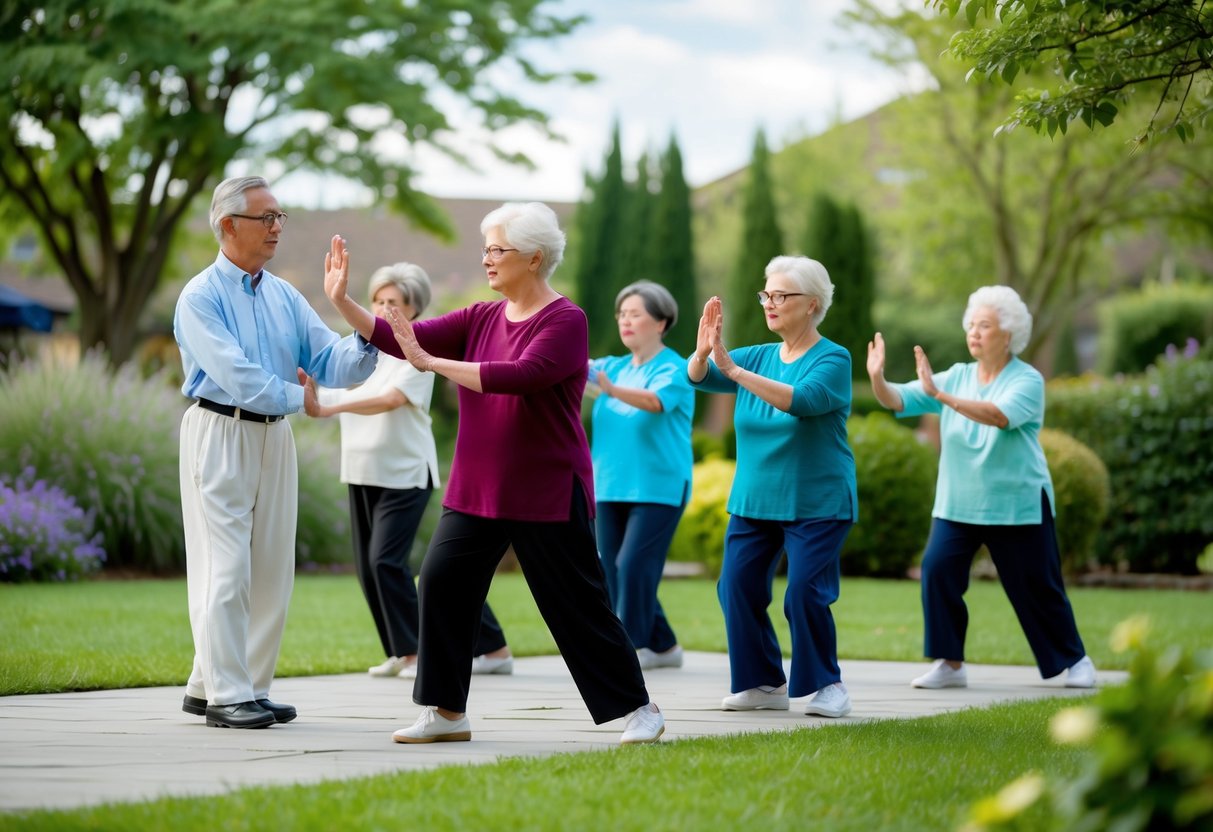
Seniors with visual impairments can enjoy the many benefits of Tai Chi. With some adaptations and support, you can overcome obstacles and dispel myths about this practice.
Navigating Challenges with Visual Impairments
You might worry about balance and safety when practicing Tai Chi with limited vision. Don’t let this stop you! Tai Chi can actually improve your balance and reduce fall risks.
Try these tips:
• Use a sturdy chair or wall for support • Practice on a non-slip surface • Wear comfortable, stable shoes
Ask an instructor or friend to guide you through movements. They can provide verbal cues and gentle touch to help you learn the forms.
As you practice, you’ll develop body awareness and may find your balance improving.
Tai Chi’s gentle movements can also help reduce pain from conditions like arthritis. The slow, controlled motions are easy on your joints.
Debunking Myths About Tai Chi for Seniors
You might think Tai Chi is too challenging or only for young, fit people. This isn’t true! Tai Chi is adaptable for all ages and abilities.
Common myths:
• “It’s too complicated” – Tai Chi can be simplified. Start with basic moves and build up slowly. • “I need perfect balance” – Tai Chi helps improve balance over time. You don’t need to start out perfect. • “It won’t help my memory” – Tai Chi may actually slow cognitive decline in those with mild dementia.
Remember, Tai Chi is a journey. You’ll gain benefits like improved flexibility, strength, and mental focus with regular practice. Don’t let misconceptions hold you back from trying this rewarding activity.
Tai Chi for Seniors with Visual Impairments: A Path to Wellness
Tai Chi, a gentle exercise rooted in ancient Chinese philosophy, offers numerous benefits for seniors, particularly those with visual impairments. Its slow, deliberate movements, coupled with deep breathing, can significantly improve balance, flexibility, and strength. Beyond the physical advantages, Tai Chi promotes mental clarity, reduces stress, and enhances overall well-being.
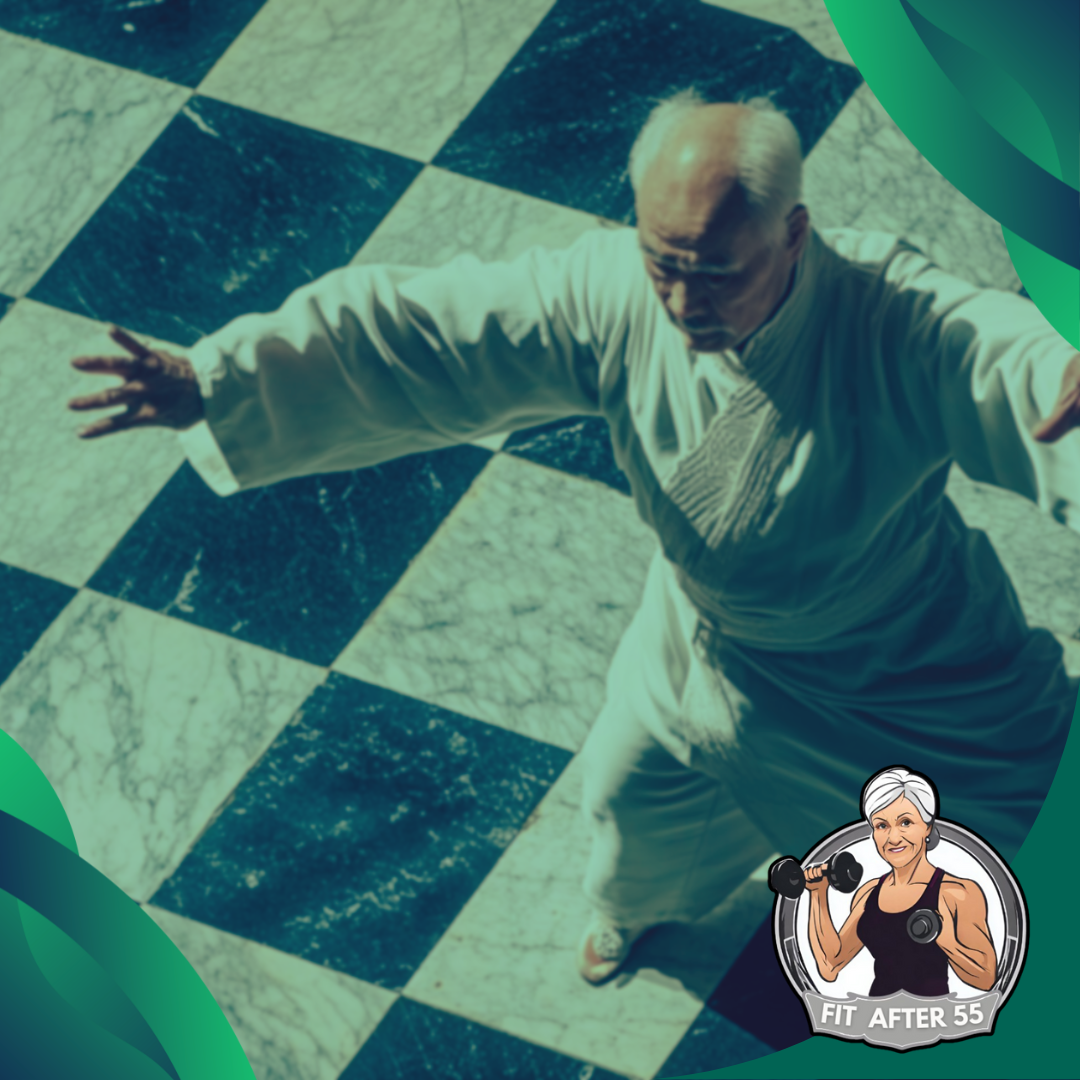
The beauty of Tai Chi lies in its adaptability. It can be modified to suit various levels of physical ability and visual acuity. Whether practiced seated or standing, with or without a partner, Tai Chi provides a safe and effective way to stay active and engaged.
If you’re a senior with visual impairments, consider incorporating Tai Chi into your daily routine. With guidance from a qualified instructor, you can unlock the transformative power of this ancient practice. Remember, it’s never too late to start.
Frequently Asked Questions

Tai Chi can be adapted for seniors with visual impairments. There are ways to modify exercises, accommodate participants, and ensure safety while improving balance and coordination.
What modifications can be made to Tai Chi exercises for seniors with sight loss?
You can practice Tai Chi with some simple changes. Chair exercises or seated Tai Chi are great options. These allow you to focus on upper body movements without worrying about balance.
You can also use props like walls or chairs for support during standing poses. This helps you feel more stable as you learn the movements.
How do instructors accommodate visually impaired participants in a Tai Chi class?
Instructors use clear, descriptive language to guide you through each move. They might offer hands-on assistance to help you understand the correct form.
Visual demonstrations are replaced with detailed verbal instructions. Some teachers use tactile cues, gently touching your arms or legs to show proper positioning.
What are suitable safety precautions to take when teaching Tai Chi to seniors with visual impairments?
Clear the practice area of any obstacles. Make sure you have enough space to move freely without bumping into objects or other people.
Use non-slip mats for better traction. Instructors should be close by to offer support if needed. They might also pair you with a sighted partner for extra guidance.
Can Tai Chi improve balance and coordination in the visually impaired elderly?
Yes, Tai Chi can help you improve your balance and coordination. The slow, controlled movements strengthen your muscles and enhance body awareness.
Tai Chi has been shown to decrease fall risk in seniors. This is especially valuable for those with visual impairments who may struggle with balance.
Are there any particular Tai Chi styles recommended for seniors with limited vision?
Yang style Tai Chi is often recommended for beginners and seniors. Its gentle, flowing movements are easier to learn and perform.
Tai Ji Quan Moving for Better Balance is a program specifically designed for older adults. It focuses on improving balance and preventing falls.
What resources are available for visually impaired seniors practicing Tai Chi?
Audio guides and instructional CDs can help you practice Tai Chi at home. They provide step-by-step verbal instructions for each movement.
Textured mats or floor markers can help you understand your position in space. Some instructors also use tactile diagrams to explain more complex movements.
Tai Chi: A Gentle Path to Wellness for Seniors
Looking for a gentle yet effective way to improve your balance, flexibility, and overall well-being? Join our supportive community on Fit After 55 and Facebook to learn more about the benefits of Tai Chi, especially for seniors with visual impairments. Discover tips, techniques, and inspiring stories from fellow enthusiasts. Let’s embrace a healthier, happier future together!

